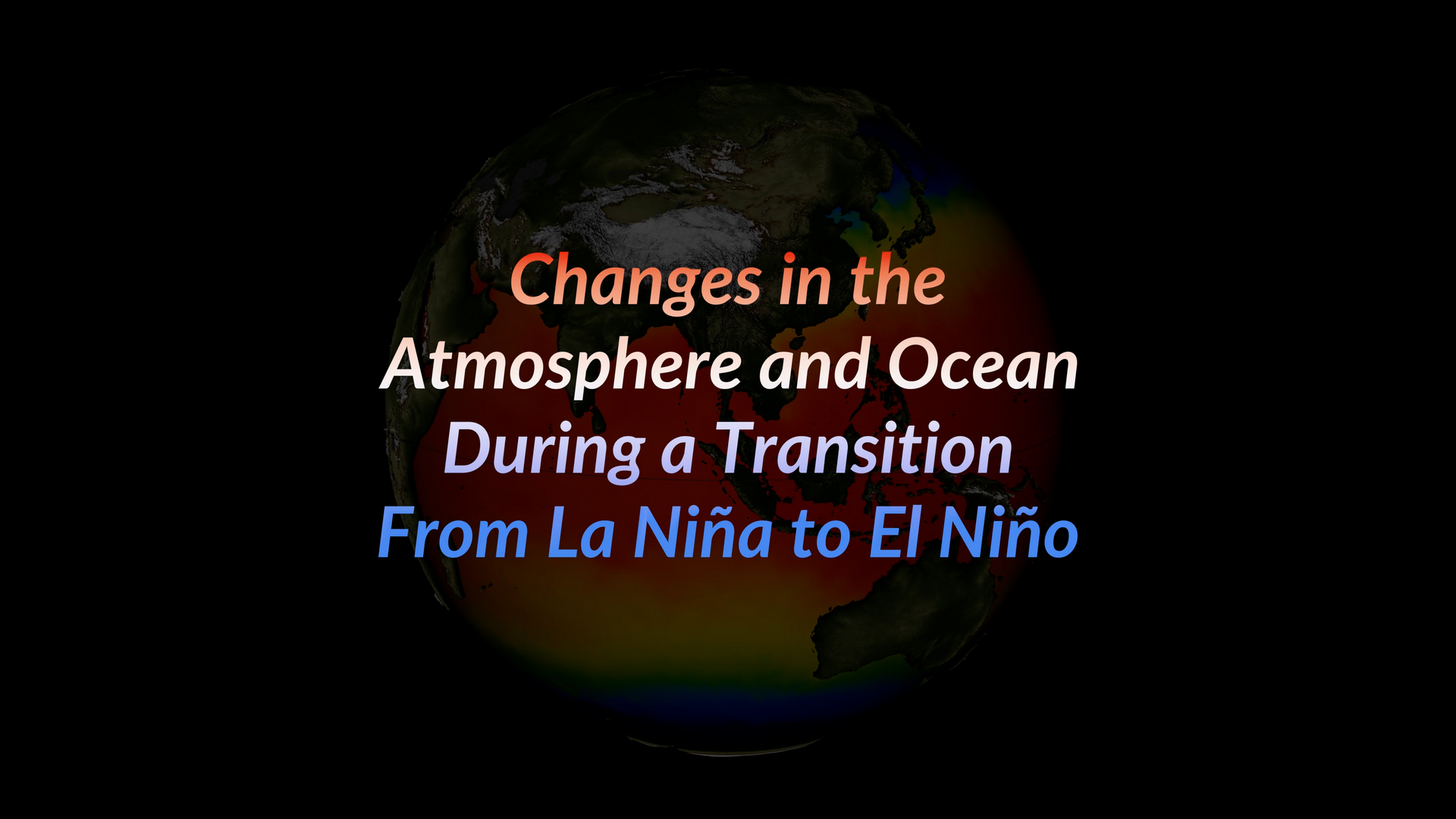Changes in the Atmosphere and Ocean During a Transition From La Niña to El Niño
This is the final version of the ENSO visualization with narration. There are HD and 4k versions available as mp4s. There is also a high quality 4k version which is very large (3.8 Gbytes). Other non-narrated formats including individual frames are available below this entry.
This movie is also available on youtube here:https://youtu.be/jK20dl3g9R8?si=38LHf1e0iIzrfhRQlink
El Niño-Southern Oscillation (ENSO), is an ocean-atmosphere coupled phenomenon that affects global weather such as rainfall and drought patterns. We use several NASA and NOAA data products (listed below) to visualize the interaction between the ocean and atmosphere during the transition from La Niña 2021 to El Niño 2023. The visualization is a comprehensive explainer showing changes in the upper 300 meters of the Pacific Ocean (such as thermocline relaxation and eastward movement of warm temperature anomalies) and the changes in the lower atmosphere (e.g., the Walker Circulation). It is among the first efforts in visualizing the Walker Circulation and its convective branch moving across the Pacific without schematic plots but rather with verified model outputs.
We start by showing the surface temperature around the globe, then we zoom in to the equatorial Pacific, looking beneath the surface to see the gradient of temperature across the Pacific and how this gradient drives the movement of warm water from the West Pacific to the East Pacific as we transition from La Niña to El Niño.
Then we switch to show the surface temperature deviation from normal conditions instead of the absolute temperature. This is called the sea surface temperature anomaly. The dial shows the sea surface temperature deviation from normal in the central Pacific (the black rectangle, also known as the Nino 3.4 region). This is used as a measure for understanding how strong the El Niño and La Niña events are. As we transition from La Niña to El Niño, the index changes from negative to positive values.
In addition to temperature, the sea level also changes. The sea level is generally lower than normal during La Niña, and higher than normal during El Niño. These changes are mostly driven by the winds on the surface of the ocean. During La Niña, the strong westward blowing trade winds push surface waters to the west. As the trade winds weaken, the warm surface water sloshes back to the central Pacific, leading to a central Pacific El Niño.
We take a better look at the sea surface temperature and height anomalies, by looking at the subsurface at the equator. This temperature and height contrast across the Pacific is linked to the atmospheric circulation right above the ocean, known as the Walker Circulation. This is visualized using wind vector anomalies.
During La Niña, the warm waters in the west Pacific add extra heat to the air, resulting in rising motion where there are more clouds and rainfall. As we transition to El Niño, the surface trade winds weaken, the warm water anomalies spread eastward, and the convective rising branch of the Walker Circulation shifts to the central and east Pacific.
These changes in the atmosphere and ocean influence the global weather. We show the effect of El Niño versus La Niña by showing where rainfall changes.
We also visualize the effect of ENSO on marine life. During La Niña, there’s more upwelling of cold water off the coast of Peru. Therefore, there is a higher population of zooplankton which attract fish schooling.
This is the final version of the ENSO visualization without narration. There are HD, 4k and hyperwall resolution versions available including frames.
Credits
Please give credit for this item to:
NASA's Scientific Visualization Studio
music: Universal Music Production: "April Fools Instrumental"
-
Visualizers
-
Atousa Saberi
(NASA/GSFC)
-
Greg Shirah
(NASA/GSFC)
-
Atousa Saberi
(NASA/GSFC)
-
Scientists
-
Atousa Saberi
(NASA/GSFC)
- Eric Hackert (NASA/GSFC)
- Young-Kwon Lim (USRA)
-
Atousa Saberi
(NASA/GSFC)
-
Narrator
-
Atousa Saberi
(NASA/GSFC)
-
Atousa Saberi
(NASA/GSFC)
-
Writer
-
Atousa Saberi
(NASA/GSFC)
-
Atousa Saberi
(NASA/GSFC)
-
Producers
- Jefferson Beck (eMITS)
- Kathleen Gaeta (Advocates in Manpower Management, Inc.)
-
Technical support
- Laurence Schuler (ADNET Systems, Inc.)
- Ian Jones (ADNET Systems, Inc.)
Series
This page can be found in the following series:Datasets used
-
chlor_a (Chlorophyll Concentration OCl) [Aqua: MODIS]
ID: 935Credit: Ocean Biology Processing Group (OBPG)
This dataset can be found at: http://oceancolor.gsfc.nasa.gov/cms/atbd/chlor_a
See all pages that use this dataset -
MERRA-2 (MERRA-2)
ID: 1134 -
GEOS-S2S
ID: 1213NASA Goddard Earth Observing System (GEOS) Subseasonal to Seasonal (S2S) coupled ocean-atmosphere model
This dataset can be found at: https://gmao.gsfc.nasa.gov/seasonal/GEOS-S2S/
See all pages that use this dataset -
Niño3.4 SST anomaly index
ID: 1214NOAA Niño3.4 Reynolds Optimum Interpolation v2 (Olv2) Sea Surface Temperature (SST) anomaly index time series.
This dataset can be found at: https://www.ncei.noaa.gov/products/optimum-interpolation-sst
See all pages that use this dataset -
WOA23
ID: 1215NOAA World Ocean Atlas 2023 (WOA23):
This dataset can be found at: https://www.ncei.noaa.gov/products/world-ocean-atlas
See all pages that use this dataset -
ETOPO-30
ID: 1216NOAA Earth TOPOgraphy global relief model 30 arc-second resolution (ETOPO-30): The ETOPO Global Relief Model integrates topography, bathymetry, and shoreline data from regional and global datasets to enable comprehensive, high resolution renderings of geophysical characteristics of the earth’s surface. The model is designed to support tsunami forecasting, modeling, and warning, as well as ocean circulation modeling and Earth visualization.
This dataset can be found at: https://www.ncei.noaa.gov/products/etopo-global-relief-model
See all pages that use this dataset
Note: While we identify the data sets used on this page, we do not store any further details, nor the data sets themselves on our site.
Release date
This page was originally published on Wednesday, August 14, 2024.
This page was last updated on Sunday, March 16, 2025 at 11:07 PM EDT.
